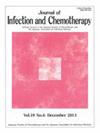A retrospective observational study of the nosocomial outbreak caused by human rhinovirus A34
IF 1.5
4区 医学
Q3 INFECTIOUS DISEASES
引用次数: 0
Abstract
Background
Past reports of nosocomial outbreak due to human rhinovirus (HRV) in adults are limited. We report a case of nosocomial outbreak of HRV-A34 in a long-term care facility with a literature review.
Methods
Multiplex real-time polymerase chain reaction assay (Allplex™ RV Essential Assay) was used for the detection of HRV. After whole genome sequencing (WGS), genomic data of HRV-A strains obtained from the GenBank database were used for phylogenetic comparison with outbreak strains.
Results
A nosocomial outbreak of HRV occurred between August 22 and September 4, 2021. During the outbreak, 17 patients had respiratory symptoms and 14 patients were positive for HRV. Additionally, HRV was detected in nine asymptomatic patients. The attack rate reached 58 %. HRV was identified five days after the onset of index case and the outbreak was terminated in 13 days. There were no significant differences on their median age (37 vs 44 years old, p = 0.1221) and sex (male gender 61 % vs 39 %, p = 1.000) between symptomatic and asymptomatic HRV patients. No patients developed pneumonia and died. WGS showed that outbreak strains were genetically identical and belonged to the HRV-A34. Literature review showed past outbreaks were caused by either HRV-A or HRV-C, and the mortality rate was reported to be 22 % at highest. The present report is the first case of nosocomial outbreak of HRV-A34.
Conclusion
Although nosocomial HRV infection is difficult to suppress, even with strengthened infection control measures, prompt identification of HRV is important. HRV should not be underestimated, especially in long-term care facilities.
人鼻病毒A34引起医院暴发的回顾性观察研究
背景过去关于成人人鼻病毒(HRV)在医院暴发的报道是有限的。我们报告一例在长期护理机构的医院内爆发的HRV-A34并进行文献综述。方法采用多重实时聚合酶链反应法(Allplex™RV Essential assay)检测HRV。全基因组测序(WGS)后,利用GenBank数据库中获得的HRV-A株基因组数据与暴发株进行系统发育比较。结果2021年8月22日至9月4日发生了一起HRV院内暴发。疫情期间,17名患者出现呼吸道症状,14名患者HRV呈阳性。此外,在9名无症状患者中检测到HRV。攻击率达到58%。在指示病例发病5天后确定了HRV,并在13天后终止了疫情。有症状和无症状HRV患者的中位年龄(37岁vs 44岁,p = 0.1221)和性别(男性61% vs 39%, p = 1.000)无显著差异。没有患者发生肺炎并死亡。WGS结果显示,暴发毒株基因相同,属于HRV-A34。文献回顾显示,过去的暴发是由HRV-A或HRV-C引起的,据报道死亡率最高为22%。本报告是第一例院内暴发的HRV-A34病例。结论虽然HRV院内感染难以抑制,但即使加强感染控制措施,及时识别HRV仍是重要的。不应低估HRV,特别是在长期护理设施中。
本文章由计算机程序翻译,如有差异,请以英文原文为准。
求助全文
约1分钟内获得全文
求助全文
来源期刊

Journal of Infection and Chemotherapy
INFECTIOUS DISEASES-PHARMACOLOGY & PHARMACY
CiteScore
4.10
自引率
4.50%
发文量
303
审稿时长
47 days
期刊介绍:
The Journal of Infection and Chemotherapy (JIC) — official journal of the Japanese Society of Chemotherapy and The Japanese Association for Infectious Diseases — welcomes original papers, laboratory or clinical, as well as case reports, notes, committee reports, surveillance and guidelines from all parts of the world on all aspects of chemotherapy, covering the pathogenesis, diagnosis, treatment, and control of infection, including treatment with anticancer drugs. Experimental studies on animal models and pharmacokinetics, and reports on epidemiology and clinical trials are particularly welcome.
 求助内容:
求助内容: 应助结果提醒方式:
应助结果提醒方式:


